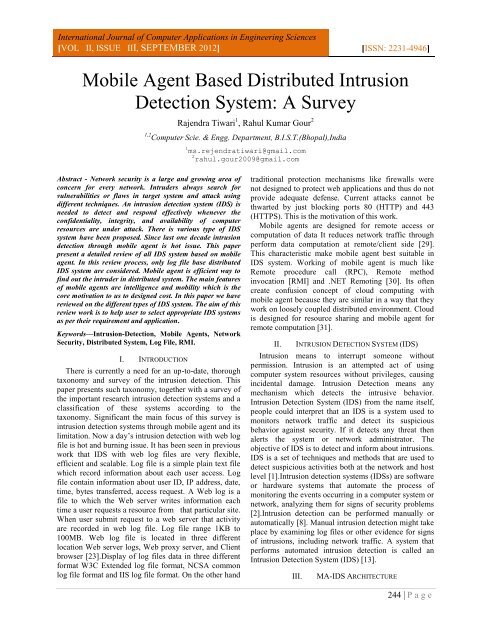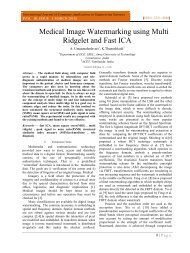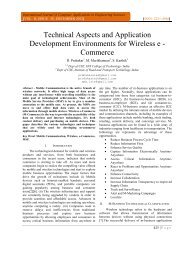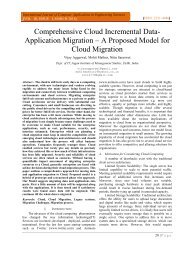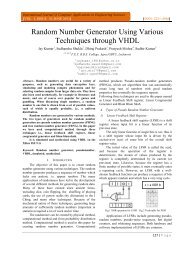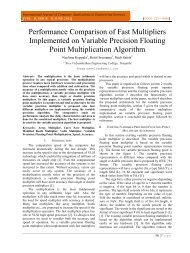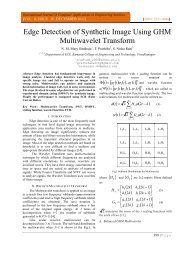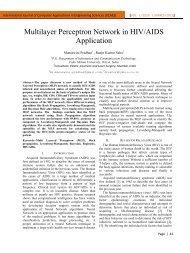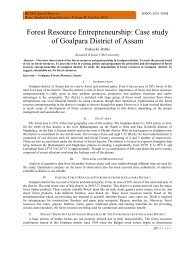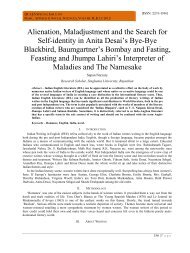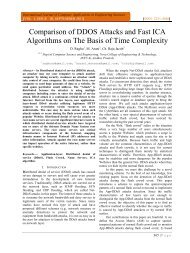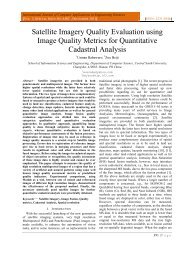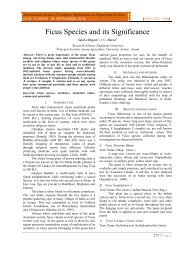Mobile Agent Based Distributed Intrusion Detection System: A Survey
Mobile Agent Based Distributed Intrusion Detection System: A Survey
Mobile Agent Based Distributed Intrusion Detection System: A Survey
You also want an ePaper? Increase the reach of your titles
YUMPU automatically turns print PDFs into web optimized ePapers that Google loves.
International Journal of Computer Applications in Engineering Sciences[VOL II, ISSUE III, SEPTEMBER 2012] [ISSN: 2231-4946]<strong>Mobile</strong> <strong>Agent</strong> <strong>Based</strong> <strong>Distributed</strong> <strong>Intrusion</strong><strong>Detection</strong> <strong>System</strong>: A <strong>Survey</strong>Rajendra Tiwari 1 , Rahul Kumar Gour 21,2 Computer Scie. & Engg. Department, B.I.S.T.(Bhopal),India1 ms.rejendratiwari@gmail.com2 rahul.gour2009@gmail.comAbstract - Network security is a large and growing area ofconcern for every network. Intruders always search forvulnerabilities or flaws in target system and attack usingdifferent techniques. An intrusion detection system (IDS) isneeded to detect and respond effectively whenever theconfidentiality, integrity, and availability of computerresources are under attack. There is various type of IDSsystem have been proposed. Since last one decade intrusiondetection through mobile agent is hot issue. This paperpresent a detailed review of all IDS system based on mobileagent. In this review process, only log file base distributedIDS system are considered. <strong>Mobile</strong> agent is efficient way tofind out the intruder in distributed system. The main featuresof mobile agents are intelligence and mobility which is thecore motivation to us to designed cost. In this paper we havereviewed on the different types of IDS system. The aim of thisreview work is to help user to select appropriate IDS systemsas per their requirement and application.Keywords—<strong>Intrusion</strong>-<strong>Detection</strong>, <strong>Mobile</strong> <strong>Agent</strong>s, NetworkSecurity, <strong>Distributed</strong> <strong>System</strong>, Log File, RMI.I. INTRODUCTIONThere is currently a need for an up-to-date, thoroughtaxonomy and survey of the intrusion detection. Thispaper presents such taxonomy, together with a survey ofthe important research intrusion detection systems and aclassification of these systems according to thetaxonomy. Significant the main focus of this survey isintrusion detection systems through mobile agent and itslimitation. Now a day’s intrusion detection with web logfile is hot and burning issue. It has been seen in previouswork that IDS with web log files are very flexible,efficient and scalable. Log file is a simple plain text filewhich record information about each user access. Logfile contain information about user ID, IP address, date,time, bytes transferred, access request. A Web log is afile to which the Web server writes information eachtime a user requests a resource from that particular site.When user submit request to a web server that activityare recorded in web log file. Log file range 1KB to100MB. Web log file is located in three differentlocation Web server logs, Web proxy server, and Clientbrowser [23].Display of log files data in three differentformat W3C Extended log file format, NCSA commonlog file format and IIS log file format. On the other handtraditional protection mechanisms like firewalls werenot designed to protect web applications and thus do notprovide adequate defense. Current attacks cannot bethwarted by just blocking ports 80 (HTTP) and 443(HTTPS). This is the motivation of this work.<strong>Mobile</strong> agents are designed for remote access orcomputation of data It reduces network traffic throughperform data computation at remote/client side [29].This characteristic make mobile agent best suitable inIDS system. Working of mobile agent is much likeRemote procedure call (RPC), Remote methodinvocation [RMI] and .NET Remoting [30]. Its oftencreate confusion concept of cloud computing withmobile agent because they are similar in a way that theywork on loosely coupled distributed environment. Cloudis designed for resource sharing and mobile agent forremote computation [31].II.INTRUSION DETECTION SYSTEM (IDS)<strong>Intrusion</strong> means to interrupt someone withoutpermission. <strong>Intrusion</strong> is an attempted act of usingcomputer system resources without privileges, causingincidental damage. <strong>Intrusion</strong> <strong>Detection</strong> means anymechanism which detects the intrusive behavior.<strong>Intrusion</strong> <strong>Detection</strong> <strong>System</strong> (IDS) from the name itself,people could interpret that an IDS is a system used tomonitors network traffic and detect its suspiciousbehavior against security. If it detects any threat thenalerts the system or network administrator. Theobjective of IDS is to detect and inform about intrusions.IDS is a set of techniques and methods that are used todetect suspicious activities both at the network and hostlevel [1].<strong>Intrusion</strong> detection systems (IDSs) are softwareor hardware systems that automate the process ofmonitoring the events occurring in a computer system ornetwork, analyzing them for signs of security problems[2].<strong>Intrusion</strong> detection can be performed manually orautomatically [8]. Manual intrusion detection might takeplace by examining log files or other evidence for signsof intrusions, including network traffic. A system thatperforms automated intrusion detection is called an<strong>Intrusion</strong> <strong>Detection</strong> <strong>System</strong> (IDS) [13].III.MA-IDS ARCHITECTURE244 | P a g e
Tiwari et. al.IDS implemented using mobile agent is one of newparadigms for intrusion detection. MAs are particularsoftware agents having the capability to move from onehost to another. <strong>Mobile</strong> agents offer unique features thatcan be used to improve the ways in which IDS aredesigned, developed and deployed in the network. Thesoftware agent can be treated as <strong>Mobile</strong> <strong>Agent</strong>, as theyare able to migrate from one computer to anothercomputer. Even if the host machine, which launched theagent, is eliminated from the network, the agent can stillwork. Thus, the mobile agents are very powerfulprograms, which can act even in the absence of themachine that initiated them. After completion of theirassigned tasks, the mobile agents return to the hostmachine to report the result or simply terminate.intrusion. Otherwise the Host Monitor <strong>Agent</strong> keepsrecord of all activity. This record is used for futureanalysis. Fig.2 shows the working of host mobile agent.Network BaseHost Monitor <strong>Agent</strong>Network<strong>Based</strong><strong>Detection</strong>Knowledge <strong>Based</strong><strong>Detection</strong><strong>Intrusion</strong>AnalyzerHomePlatform<strong>Mobile</strong> agent<strong>Agent</strong>platform<strong>Intrusion</strong>TechniqueBehavior<strong>Based</strong><strong>Detection</strong>HostMonitor<strong>Agent</strong>Log File BaseLogFile<strong>Based</strong><strong>Detection</strong>Data tobeAnalyzed<strong>Agent</strong>platform<strong>Mobile</strong> agentFig.1 Movement of <strong>Mobile</strong> <strong>Agent</strong><strong>Agent</strong>platformFig.1 depicts the movement of an agent amongseveral agent platforms. The platform where a mobileagent originates is referred to as the home platform(controlling device), and normally is the most trustedenvironment for an agent. One or more hosts may havean agent platform, and an agent platform may supportmultiple locations or meeting places where agents caninteract. <strong>Mobile</strong> agent technology has benefited from thework done on intelligent agents, which emphasizes staticautonomous agents capable of applying applicationdomain knowledge, and the development of softwaresystems capable of supporting mobile code onheterogeneous hardware (e.g., Java technology).figureshow that mobile agent gathered data and send back tothe controlling device. Controlling device is a rule baseddevice which applies some rule on that gathered data forfinding intrusion detection or future analysis. Eachmonitored host (controlling host) in the network isinstalled with a Host Monitor <strong>Agent</strong>. The Host Monitor<strong>Agent</strong> has type of rule to complete local intrusiondetection function. If the intrusion can be determined atmonitored host, the Host Monitor <strong>Agent</strong> reports theintrusion directly and takes appropriate action againstFig.2 Host Monitor <strong>Agent</strong> StructureIV. TYPES OF INTRUSION DETECTION SYSTEMThere are two ways to protect our network againstmalicious attempts. First is to build complete securenetwork system by applying all complicatedcryptographic, authentication and authorizationmethods. However, this solution is not realistic. Inpractice, it is impossible to have completely securesystem, because the user uses operating system andother applications to accomplish his/her job. Almost allapplications have one or the other vulnerabilities.Second way is to detect an attack as soon as possiblepreferably in real-time and take appropriate action. Thisis essentially what an <strong>Intrusion</strong> <strong>Detection</strong> andPrevention <strong>System</strong> (IDS and IPS) does. An IDS does notusually take preventive measures when an attack isdetected; it is a reactive rather than pro-active [3].A. Knowledge-<strong>Based</strong> IDSKnowledge-based design detects intruders by patternmatchinguser activity against known attack signatures.Signatures are kept in a database containing a repertoireof information describing normal, suspicious, or attackbehavior. Strength of misuse detection paradigm is thatwhen it signals that an attack has occurred, it is verylikely that an attack has actually occurred [21]. On the245 | P a g e
<strong>Mobile</strong> <strong>Agent</strong> <strong>Based</strong> <strong>Distributed</strong> <strong>Intrusion</strong> <strong>Detection</strong> <strong>System</strong>: A <strong>Survey</strong>other hand we can say that it applies the knowledgeaccumulated about specific attacks and systemvulnerabilities. The intrusion detection system containsinformation about these vulnerabilities and looks forattempts to exploit these vulnerabilities. When such anattempt is detected, an alarm is triggered. It means anyaction that is not explicitly recognized as an attack isconsidered acceptable. Therefore, the accuracy ofknowledge-based intrusion detection systems isconsidered good. However, their completeness (i.e. thefact that they detect all possible attacks) depends on theregular update of knowledge about attacks.PROS:1) Very low false alarm rate.2) It will provide good prevention method.3) It is easy to understand the problem and takeprevention or correction action.CONS:1) Difficult to gathering the required informationon the known attack.2) It is required to keep information up to datewith new vulnerabilities and environment.3) It is time-consuming because it is requiredcarefully analysis of each vulnerability.4) It’s depending on the operating system version,platform and application because knowledgeabout attack are focused on operating system.B. Host <strong>Based</strong> IDSHost-based intrusion detection systems analyze datathat originates on computers, such as application andoperating system event logs and file attributes. Host datasources are numerous and varied, including operatingsystem event logs, such as kernel logs, and applicationlogs such as syslog [1] [22]. These host event logscontain information about file accesses and programexecutions associated with inside users. If protectedcorrectly, event logs may be entered into court tosupport the prosecution of computer criminals [19].HIDS monitor traffic on its host machine by utilizing theresources of its host to detect attacks[4] [9].PROS:1) Host-based IDS can analyze activities on thehost so it can determine which processes and/orusers are involved in malicious activities.2) Host-based IDS is easy to use in switch basednetwork (HIGH SPEED NETWORK).3) Host-based IDSs can use host-based encryptionservices to examine encrypted traffic, data,storage, and activity.4) Host-based intrusion detection detects insidermisuse .CONS:1) Host based IDS serves the purpose to detectattack patterns that can only or easier to befound on a host level basis.2) Data collection occurs on a per-host basis so ifhost is damaged , it will harm overallperformance on the detection.3) Writing to logs or reporting activity requiresnetwork traffic and can decrease networkperformance.C. Network <strong>Based</strong> IDSNetwork-based intrusion detection systems (NIDS)are IDSs that operate as stand-alone devices on anetwork. NIDS monitors traffic on the network to detectattacks such as denial of service attacks; port scans oreven attempts to crack into computers by monitoringnetwork traffic[1] [8] [9]. Network based intrusiondetection systems come in the form of software or fullyintegrated appliance. [14] [18][22] .<strong>Intrusion</strong> detection isnetwork-based when the system is used to analyzenetwork packets. Network based <strong>Intrusion</strong> <strong>Detection</strong> andPrevention <strong>System</strong> (NIDPS) capture the network trafficfrom the wire as it travels to a host. This can beanalyzed for a particular signature or for unusual orabnormal behaviors. Several sensors are used to sniff thepackets on network which are basically computersystems designed to monitor the network traffic. If anysuspicious or anomaly behavior occurs then they triggeran alarm and pass the message to the central computersystem or administrator (which monitors the IDPS) thenan automatic response is generated [19] [20] [26]PROS:1) Network-based IDSs can monitor an entire,network and impose little overhead on anetwork.2) Network-based IDSs are mostly passivedevices that monitor ongoing network activitywithout adding significant overhead orinterfering with network operation.3) Easy to secure against attack and may even beundetectable to attackers.4) Network intrusion detection detects outsidermisuse.CONS:1) Introduction Detecting Attacks on WebApplications High traffic load makes it difficultto analyze network traffic (in real time).246 | P a g e
Tiwari et. al.2) The HTTP traffic may be SSL encrypted(HTTPS) There may be no NIDS (hard todeploy; another zone of attack).3) NIDS are designed to work on the TCP/IPlevel, and thus they may not be as effective onthe HTTP layer; IDS evasion techniques(HTTP, encoding ).4) NIDS cannot be analysis encrypted data5) NIDS may not be able to monitor switchbased(high-speed).D. Behavior-<strong>Based</strong> IDSWhen the intrusion-detection system uses informationabout the normal behavior of the <strong>System</strong> Behavior ondetection describes the response of the intrusiondetection system to attacks [16]. The behavior-baseddesign uses statistical methods or artificial intelligencein order to detect attacks. Profiles of normal activity arecreated and stored in a database. Activity gathered bythe event generator that deviates from the normal profilein a statistically significant way can be deemed assuspicious activity or an attack. The strength of anomalydetection systems is that they can detect new attacks andthere is no requirement to enter attack signatures into adatabase [21].PROS:1) Able to detect new and unforeseenvulnerabilities.2) Less dependency on operating -system-specificmechanism.3) It is also useful to detect "abuse of privilege"types of attack.4) Its speed is fast comparing to the knowledgebased IDS because it is not depend on the rules.CONS:1) It is difficult to implement.2) It may be more resource-hungry thanknowledge-based IDS.3) It may require frequent fine-tuning byadministrator.E. Anomaly <strong>Detection</strong> <strong>System</strong>sAnomaly detection technique store the systemsnormal behavior such as kernel information, system logsevent, network packet information, software runninginformation, operating system information etc into thedatabase. If any abnormal behavior or intrusive activityoccurs in the computer system which deviates fromsystem normal behavior then an alarm is generated.Anomalous activities that are not intrusive are flagged asintrusive. This will result in false-positive, i.e. falsealarm. Intrusive activities that are not anomalous resultin false negative [1] [10]. The anomaly based detectionis based on defining the network behavior. The networkbehavior is in accordance with the predefined behavior,then it is accepted or else it triggers the event in theanomaly detection. The accepted network behavior isprepared or learned by the specifications of the networkadministrators [5] [11].The normal profiles (or normalbehaviors) of users are kept in the system. The systemcompares the captured data with these profiles, and thentreats any activity that deviates from the baseline as apossible intrusion by informing system administrators orinitializing a proper response [16][25].PROS:1) New attacks and vulnerability will be detectedas soon as they take place.2) ABS can be applied also to ad-hoc networkedsystems such as web-based services.CONS:1) ABS needs an extensive model building phase:a significant amount of data (and thus asignificant period of time) is needed to buildaccurate models of legal behavior.F. Misuse <strong>Detection</strong> <strong>System</strong>sThe system keeps patterns (or signatures) of knownattacks and uses them to compare with the captured data.Any matched pattern is treated as an intrusion. Like avirus detection system, it cannot detect new kinds ofattacks [6] [17]. Misuse detection, attempts to encodeknowledge about attacks as well defined patterns andmonitors for the occurrence of these pattern andmonitors for the occurrence of these pattern forexample, exploitation of the fingered and send mail bugsused in the Internet Worm attack .on the other hand itsay that This technique involves the comparison of auser's activities with the known behaviors of attackersattempting to penetrate a system. Misuse detection alsoutilizes a knowledge base of information. The misuseknowledge bases include specific metrics on the varioustechniques employed by attackers when the knowledgebase was created [24] [27].PROS:1) Misuse detection also utilizes a knowledge baseof information.2) It is the best technology to detect intruder on theprevious knowledge.3) Misuse detection system looking for theexploitation of known weak points in thesystem, or sequence of events or data.247 | P a g e
<strong>Mobile</strong> <strong>Agent</strong> <strong>Based</strong> <strong>Distributed</strong> <strong>Intrusion</strong> <strong>Detection</strong> <strong>System</strong>: A <strong>Survey</strong>CONS:1) Misuse detection systems suffer from thepotential performance degradation it isdepended on audit trails for input.2) It is required previous knowledge to detectintrusion.3) For the known weak point in the system itrequired a specific pattern.V. IDS CHALLENGESSome shortcomings are inherent when IDSs areconstructed [28]. The most common shortcomingsinclude the following itemsA. Lack of EfficiencyIDSs are often required to evaluate events in realtime. This requirement is difficult to meet when facedwith a very large number of events as is typical intoday’s networks. Consequently, host-based IDSs oftenslow down a system and network-based IDSs dropnetwork packets that they do not have time to process.B. High Number of False PositivesMost IDSs detect attacks throughout an enterprise byanalyzing information from a single host, a singleapplication, or a single network interface, at manylocations throughout the network. False alarms are highand attack recognition is not perfect. Loweringthresholds to reduce false alarms raises the number ofattacks that get through undetected as false negativesC. Burdensome MaintenanceThe configuration and maintenance of intrusiondetection systems often requires special knowledge andsubstantial effort. For example, misuse detection hasusually been implemented using expert system shellsthat encode and match signatures using rule sets.Upgrading rule sets involves details peculiar to theexpert system and its language for expressing rules sets,and may permit only an indirect specification of thesequential interrelationshipsbetween events.Similar considerations may apply to the addition of astatistical metric, typically used for detecting unusualdeviations in behavior.D. Limited Flexibility<strong>Intrusion</strong> detection systems have typically beenwritten for a specific environment and have proveddifficult to use in other environments that may havesimilar policies and concerns. The detection mechanismcan also be difficult to adapt to different patterns ofusage. Tailoring detection mechanisms specifically tothe system in question and replacing them over timewith improved detection techniques is also problematicwith many IDS implementations. Often the IDS needs tobe completely restarted in order to make changes andadditions take effect Vulnerability to Direct AttackE. End-to-end EncryptionWith security improvements in communicationsprotocols, the ability to encrypt traffic on an end-to-endbasis is on the rise. Besides thwarting an eavesdropper,encrypted content keeps network-based IDS frompeeking into packets and analyzing their contents forintrusions.F. High Speed CommunicationsHigher communication traffic rates directly affect theprocessing speed needed to analyze packet content,potentially resulting in lost packets. The trend towardswitched communications over broadcast also increasesthe difficulty for network-based IDS to monitor multiplecommunications streams.G. Breadth of AttacksAs new attacks are conceived, IDSs must be updatedto discover them. While new attacks are addedfrequently, old ones can seldom be dropped. Typically,the greater the attack coverage, the more processingtime that is needed by the detection algorithm.VI. BEST SOLUTION WITH MOBILE AGENTThe software agent can be treated as <strong>Mobile</strong> <strong>Agent</strong>,as they are able to migrate from one computer to anothercomputer. Even if the host machine, which launched theagent, is eliminated from the network, the agent can stillwork. Thus, the mobile agents are very powerfulprograms, which can act even in the absence of themachine that initiated them. After completion of theirassigned tasks, the mobile agents return to the hostmachine to report the result or simply terminate [15]. So<strong>Mobile</strong> agent is a type of software agent, with thefeature of autonomy, social ability, learning, and mostimport, mobility. <strong>Mobile</strong> agents have some advantagesthat are [7] [13].A. Overcoming Network LatencySince agents operate directly on the host, where anaction has to be taken, their response is faster thanhierarchical systems, where the actions are taken bycentral coordinator.B. Reducing Network LoadInstead of sending audit data from sensors to centralstations, sending the code of the agent may cause littlenetwork load, because audit data may become hugeamounts.C. Autonomous Execution248 | P a g e
Tiwari et. al.In order to prevent letting the whole networkundefended, when a part of the IDS fails, agents canwork autonomously even if their creators don’t operateanymore.D. Platform IndependenceWhere the agents run on the agent platform, they areindependent from the platform of the host.E. Dynamic NatureThe dynamic nature of mobile agents enables them tobe moved around the network. This makes it possible toreconfigure the system during runtime also. <strong>Mobile</strong>agents can be cloned, dispatched or put to sleep whenthe network configuration has to be changedF. Heterogeneous Environment<strong>Mobile</strong> agents can be interoperable on multipleplatforms. This is possible because of the virtualinterpreter installed on the host machine. <strong>Mobile</strong> agentsare generally computer and transport-layer independentand are dependent only on the execution environment.This feature enables the mobile agents to be used onseveral different platforms without compatibilityproblems.G. Structure and Platform Independence<strong>Mobile</strong> agents can be used in IDS with a flexiblestructure. For example, one agent can be designated forcollecting the data in the network, the other agent can beused to detect and report anomalies while the rest ofthem can be used to take appropriate action.H. Dynamic AdaptionThe system can be reconfigured at run-time becauseof the agent’s dynamic behavior.I. Static AdaptionWhen a new attack signature has to be added to theIDS, the algorithm of the agents can be updated withoutrestarting the whole system.J. Scalability<strong>Mobile</strong> agents reduce the computational load on thesystem by dividing it different hostsVII.CONCLUSIONSDifferent intrusion detection systems and its pros,cons are discussed in this paper to support the securityof an organization against unwanted threats or attacks.On the other side attackers are discovering newtechniques and ways to break these security policies.Firewalls, antivirus and antispyware are limited toprovide security to the system against threats. The onlyway to beat them is to up to date knowledge about theirtechniques that they use for attack. We also discussedabout mobile agents and how it can be worked up on thelog data. Moreover, using mobile agents in IDS wouldincrease the integrity of a database in which it wouldkeep records of what type of intrusion the mobile agent.Common communication format for exchanging rulesor log between agents to remote agent are also inconsideration.ACKNOWLEDGMENTI would like to acknowledge and extend my heartfeltgratitude to Mr. Vivek Tiwari, Researcher (PhD) atMaulana Azad National Institute of Technology(MANIT-Bhopal), for their expertise, stimulatingsuggestions, experience and encouragement in all thetimes of research period.REFERENCES[1] U. A. Sandhu , S. Haider , S. Naseer , and O. U. Ateeb , “A<strong>Survey</strong> of <strong>Intrusion</strong> <strong>Detection</strong> & Prevention Techniques”,IPCSIT vol.16, IACSIT Press, Singapore 2011.[2] K. Maskat, Md. A. Shukran, Md. A. Khairuddin, and Md. R.Isa, “<strong>Mobile</strong> <strong>Agent</strong>s in <strong>Intrusion</strong> <strong>Detection</strong> <strong>System</strong>: Review andAnalysis ”, Vol. 5, No. 6, December 2011.[3] Dr. B. Trivedi , J. Rajput , C. Dwivedi ,and P.Jobanputra,“<strong>Distributed</strong> <strong>Intrusion</strong> <strong>Detection</strong> <strong>System</strong> using <strong>Mobile</strong> <strong>Agent</strong>s ”,Proc .of CSIT vol.1 IACSIT Press, Singapore 2011.[4] N. Verma, Dr. Md. Husain,and M. K. Shukla, “Research on<strong>Mobile</strong> agent based network intrusion”, Vol. 2, ISSue 2, June2011.[5] V. Jyothsna, V .V. Rama Prasad,and K . Munivara Prasad, “AReview of Anomaly based <strong>Intrusion</strong> <strong>Detection</strong> <strong>System</strong>s ”,Volume 28– No.7, August 2011.[6] D. Damopoulos, S. A. Menesidou,G. Kambourakis,M.Papadaki2, N.Clarke and S. Gritzalis, “Evaluation ofAnomaly-<strong>Based</strong> IDS for <strong>Mobile</strong> Devices Using MachineLearning Classifiers ” , Security Comm. Networks ,1–9 ,2011.[7] P. jain, S. Raghuwanshi and P. rk, “new mobile agent-basedintrusion detection systems for distributed networks ”, Volume1, Issue 1, 2011.[8] J. S. Rathore, “<strong>Survey</strong> on <strong>Intrusion</strong> <strong>Detection</strong> and Prevention<strong>System</strong> and Proposed Cost Effective Solution Using Software<strong>Agent</strong>” ,Volume 1, Issue 3, May 2012.[9] K.K.R and A. Indra,” <strong>Intrusion</strong> <strong>Detection</strong> Tools and Techniques– A <strong>Survey</strong>”, December, Vol.2, No.6, 2010.[10] O. Adaobi, M. Ghassemian, “Analysis of an Anomaly-based<strong>Intrusion</strong> <strong>Detection</strong> <strong>System</strong> for Wireless SensorNetworks”,International Conference on CommunicationEnginering, December 2010.[11] M. Tavallaee, N. Stakhanova, and Ali A. Ghorbani,” TowardCredible Evaluation of Anomaly-<strong>Based</strong> <strong>Intrusion</strong>-<strong>Detection</strong>Methods”, IEEE SEPTEMBER 2010[12] Syurahbil, N. Ahmad, M. F. Zolkipli, Ahmed N. Abdalla,”<strong>Intrusion</strong> Preventing <strong>System</strong> using <strong>Intrusion</strong> <strong>Detection</strong> <strong>System</strong>Decision Tree Data Mining”, Science Publications, 2009.[13] Y. Li, R. Wang, J. Xu, “A Novel <strong>Distributed</strong> <strong>Intrusion</strong><strong>Detection</strong> Model <strong>Based</strong> on Immune <strong>Mobile</strong> <strong>Agent</strong> ” May 22-24,2009.[14] R. Meyer, “Detecting Attacks on Web Applications from LogFiles”, 26 January 2008.[15] M. Singh, S. S. Sodhi, “<strong>Distributed</strong> <strong>Intrusion</strong> <strong>Detection</strong> usingAglet <strong>Mobile</strong> <strong>Agent</strong> Technology ”, March 23, 2007.249 | P a g e
<strong>Mobile</strong> <strong>Agent</strong> <strong>Based</strong> <strong>Distributed</strong> <strong>Intrusion</strong> <strong>Detection</strong> <strong>System</strong>: A <strong>Survey</strong>[16] D. Bolzoni, S.Etalle, P. Hartel,”POSEIDON: a 2-tier AnomalybasedNetwork <strong>Intrusion</strong> <strong>Detection</strong> <strong>System</strong>, 2006 IEEE.[17] T.Anantvalee ,and J. Wu, “A <strong>Survey</strong> on <strong>Intrusion</strong> <strong>Detection</strong> in<strong>Mobile</strong> Ad Hoc Networks ” , pp. 170 - 196 ,Springer 2006.[18] A. Fuchsberger,” <strong>Intrusion</strong> <strong>Detection</strong> <strong>System</strong>s and <strong>Intrusion</strong>Prevention <strong>System</strong>s”, Information Security Technical Report,2005.[19] H. Kozushko, “<strong>Intrusion</strong> <strong>Detection</strong>: Host-<strong>Based</strong> and Network-<strong>Based</strong> <strong>Intrusion</strong> <strong>Detection</strong> <strong>System</strong>s”, September 11, 2003.[20] H. Debar, M. Dacier , and A. Wespi, “Towards a taxonomy ofintrusion-detection systems” ,Research Report, 1999.[21] A.Yasinsac, S. Goregaoker, ” An <strong>Intrusion</strong> <strong>Detection</strong> <strong>System</strong> forSecurity Protocol Traffic ”, Florida State University, Florida2002.[22] C. Petersen,” an introduction to network and host basedintrusion detection”, 2003.[23] P. Patil, U. Patil, ” Preprocessing of web server log file for webmining”, NCETCT-2012.[24] J. C. J. Harrell, “A Comparative Analysis of Current <strong>Intrusion</strong><strong>Detection</strong> Technologies”.[25] R. Shanmugavadivu, “network intrusion detection system usingfuzzy logic”, ijcse,2011.[26] H. Albag, “Network & <strong>Agent</strong> <strong>Based</strong> <strong>Intrusion</strong> <strong>Detection</strong> <strong>System</strong>s”, Istanbul Tech. Uni ,TU Munich.[27] J. S. Balasubramaniyan, J. O.Garcia-Fernandez,D. Isacoff,E.Spafford, D. Zamboni”An Architecture for <strong>Intrusion</strong><strong>Detection</strong> using Autonomous <strong>Agent</strong>s”,1998.[28] W. A. Jansen, “intrusion detection with mobile agents”,2002.[29] V. Tiwari, Dr. S.K. Lenka &S. Gupta.(June-2010),”Performance Evolution of Java Remote Method Invocationand <strong>Mobile</strong> <strong>Agent</strong> Techniques in Context of <strong>Distributed</strong>Environment” IEEE International Conference on Networkingand Information Technology (ICNIT 2010) Manila, Philippines,IEEE Catalog Number:CFP1023K-PRT, ISBN:978-4244-7577-3.[30] V. Tiwari & S. Gupta” Computational Study of .NET Remotingand <strong>Mobile</strong> <strong>Agent</strong> in <strong>Distributed</strong> Environment” InternationalJournal of Computing, Volume 2, Issue 6, June-2010, ISSN:2151-9617.[31] V.Tiwari & U. Bindal,”, Cloud Computing: A next generationrevolution in IT with e –Governance” CiiT International Journalof Networking and Communication Engineering, Volume 2,DOI: NCE052012006, ISSN 0974-9616, May 2012.250 | P a g e


